The term Ayurveda emerged from the connection of the words ‚Ayu‘ (life) and ‚Veda‘ (science), analogously translated this means as much as ‚The science of life‘. This knowledge was passed on long ago from cosmic spheres to the seers and sages of ancient India to transform it into words and language. It is mentioned in the history books that this was given by Maha Brahma from the divine world to Dhanvantari Rishi to establish the world of human. It was given as Ashtanga Ayurveda by dividing it into 8 parts according to the human brain capacity and easy to understand. The teachings of Ayurveda are in harmony with nature and allied with science. It is also significantly influenced by its mystical and religious aspects and can be considered as truly divine medicine. Thus, this science is, historically proven, the oldest ‚Health System‘ of the world.
Even today Ayurveda has many practicing users especially in India, Nepal and Sri Lanka but also in the western world there is a continuously increasing interest.
The basic elements of Ayurvedic practices consists of:
⦁ Maintaining health and disease prevention
⦁ Treatment for diseases
Other than that:
⦁ Massage and purification techniques
⦁ Physical and spiritual yoga practice
⦁ Organic medical treatments
⦁ A nutrition and healthcare system
All subsequent pages refer exclusively the last topic:
All about healthy cooking according to Ayurvedic rules.
Please note: Our webpages do not deal explicitly with medical aspects of Ayurveda. Our focus is on balancing body, mind and spirit in healthy status due to the culinary delights of the Ayurvedic cuisine. If you are not feeling well or sick please seek out for a competent doctor.
… or the Vedic idea of the origin of the cosmos.
In Vedic philosophy, there is the belief that before the beginning of the world, only an unmanifest state of consciousness (Avyakta) existed. It was only through the movement of the cosmos initiated by the cosmic intelligence (Mahad) and the vital life energy (Prāna) that five elements (Mahābhūtas) manifested themselves.
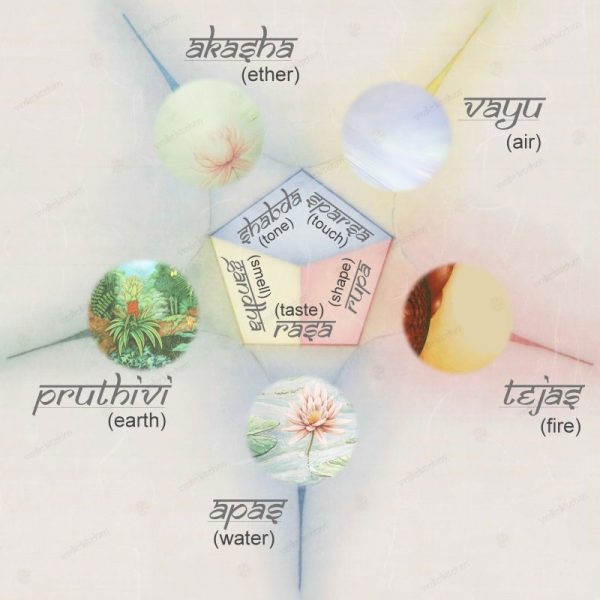
⦁ First, the first and lightest element, the ‚ether‘ element (Ākāsha), emerged.
⦁ The ‚air‘ element (Vāyu) then formed from the compression of the ether.
⦁ The friction of the air gave rise to a further condensation, the ‚fire element‘ (Tejas).
⦁ The ‚water‘ element (Āpas) condensed from the heat of the fire.
⦁ Finally, the mass solidified and formed the ‚earth‘ element (Pruthivī).
The philosophy of Ayurveda teaches that the whole world is made up of these five Mahābhūtas and exists permanently in time and space. As a reflection of nature, humans, animals and plants as well as inanimate nature also contain all five elements in their respective microcosms.
###############################################################
Ayurveda believes that the whole world is made up of five maha bhuthas.
It holds the concept that man is a small sample of the world in which he lives.
In other words, all living and non-living things in nature, including humans, are made up of pancha maha bhuthas.
But the composition of the five maha bhuthas demons that exist within each other is different.
Depending on the compositional difference, the substances show different forms.
As this has a fixed composition on each substance, it shows the unchanging and constant properties of each substance forever.
These five elements combine in various compositions to form the three doshas of Vata, Pitta and Kapha (together known as tridoshas) which are the basic elements of Ayurvedic philosophy.
The harmony of these three doshas in the human body is the state of „prakruthi“ (nature of a substance) and any imbalance of the three doshas(vikruthi) occurs in the body at any time and causes diseases.
The 5 elements are inextricably linked to the Tanmātrās, the energies of sensory perception. The Tanmātrās represent the objects of perception and form the sensory link between the subtle spheres and the concrete physical world as we experience it.
This are the five senses (Tanmātrās) of Ayurveda:

The sense of taste (rasa) and sense of smell (gandha) in particular are of great importance for the art of cooking, as these two senses work together in an essential way. The sense of taste (rasa) distinguishes only six perceptions (bitter, pungent, salty, sweet, sour, astringent), while the sense of smell (gandha) develops an almost infinite number of different flavours.
Flavour is created by gustatory stimuli in the oral cavity which are transmitted directly to the brain at the back of the throat. Odour is created by volatile scent molecules in the nose which are transmitted to the olfactory bulb in the brain via olfactory receptors (olfactory cells). The interplay of gustatory and olfactory receptors forms the flavour perception of a food.
But the other three senses also contribute, often subliminally, to the culinary experience of a meal. Think, for example, of the sight of a decoratively arranged plate, the sizzling of a pan or the sensory stimuli when you eat with your fingers. All in all, a meal is a feast for all the senses!
However, with increasing age and, in particular, illness, the quality of perception can suffer. A balanced lifestyle and healthy diet can preserve the ability of the subtle energy patterns of the Tanmātrās.
The five elements are closely associated with a series of opposing qualities (Gurvadi Gunas). The entries in the following list in dark grey colour are associated with the elements Ether (Ākāsha), Air (Vāyu) and Fire (Tejas), while the entries in light grey colour are associated with the elements Water (Āpas) and Earth (Pruthivī).
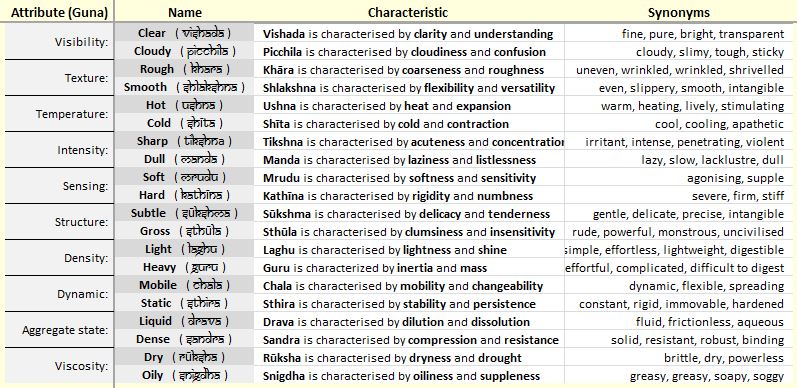
Clear (vishada) is exclusively assigned to the element Ether (Ākāsha).
Rough (Khāra) is exclusively assigned to the element Air (Vāyu).
Subtle (Sūkshma) and Light (Laghu) are assigned to the elements Ether (Ākāsha), Air (Vāyu) and Fire (Tejas).
Hot (Ushna) and Sharp (Tikshna) are exclusively assigned to the element Fire (Tejas).
Soft (Mrudu) is assigned to the two elements Ether (Ākāsha) and Water (Āpas).
Mobile (Chala) and Liquid (Drava) are assigned to the elements Air (Vāyu) and Water (Āpas).
Dry (rūksha) is assigned to the three elements Air (vāyu), Fire (tejas) and Earth (pruthivī).
Heavy (Guru) and Dull (Manda) are assigned to the elements Water (Āpas) and Earth (Pruthivī).
Cloudy (Picchila), Cold (Shīta), Smooth (Shlakshna) and Oily (Snigdha) are exclusively assigned to the element Water (Āpas).
Gross (Sthūla), Static (Sthira), Dense (Sandra) and Hard (Kathīna) are exclusively assigned to the element Earth (Pruthivī).
The following graphic shows a visualisation of the assignment of the Qualities to the Elements:
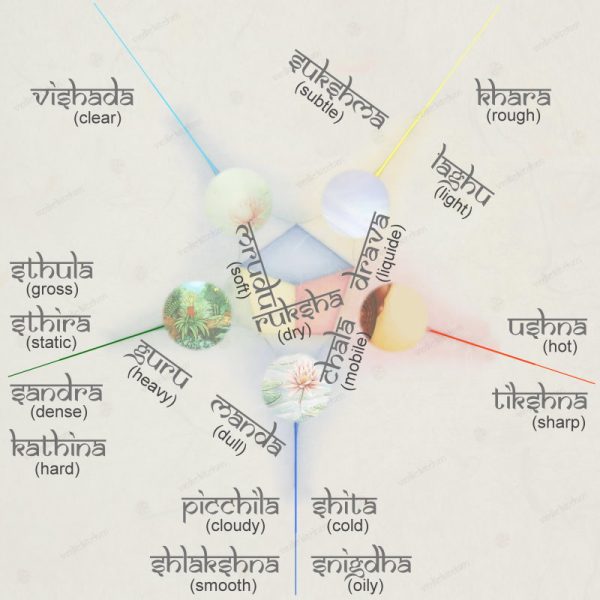
The Quantities (Gunas) describe the effect of food on the body, mind and soul. Ayurveda categorises foods and substances into 20 gunas, which are divided into ten pairs of opposing qualities:
⦁ Clear (Vishada) vs. Cloudy (Picchila)
Clear foods support purity and lightness of mind and aid digestion, while cloudy foods nourish and moisturise the tissues.
Qualitiy: Clear (vishada) refers to anything that is clear, pure, transparent or unclouded. Example: Clarity can be found in water, fresh fruit or clear broths. Effect on the body: Clear foods tend to be easy to digest and can have a cleansing, refreshing effect. They are often used in cleansing diets and fasting practices.
Qualitiy: Cloudy (picchila) refers to anything that is cloudy, opaque, unclear or present in small quantities. Example: Cloudiness can be present in highly flavoured dishes, concentrated broths or foods with heavy oils or fats. Effect on the body: Cloudy foods can be harder to digest and in larger quantities may cause stagnation or unclarity in the body.
⦁ Rough (Slakshna) vs. Smooth (Khāra)
Rough foods can cause irritation in the human organism, while smooth foods facilitate and soothe digestion.
Qualitiy: Rough (Slakshna) refers to anything that is dull, smooth, soft or pliable. Example: Foods with this quality could be cooked vegetables, ripe fruits or foods with a slightly smooth texture. Effect on the body: Dull foods tend to be easy to digest and can have a soothing effect on the stomach. They are often suitable for people with sensitive digestion.
Qualitiy: Smooth (Khāra) refers to anything that is smooth, slimy or moist. Example: Foods with this quality could be aloe vera gel, okra or foods with a slightly slimy consistency. Effect on the body: Smooth foods can help to lubricate the digestive tract and are particularly useful when moisturising is required. However, excessive consumption can lead to excessive mucus.
⦁ Hot (Ushna) vs. Cold (Shīta)
Hot foods aid digestion by providing warmth and energy, while cold foods cool the body.
Qualitiy: Hot (Ushna) refers to anything that is hot, spicy or warming. Example: Foods with this quality could be ginger, garlic or hot spices. Effect on the body: Hot foods can boost the metabolism and have a warming effect on the body. They can aid digestion and stimulate the mind.
Qualitiy: Cold (Shīta) refers to anything that is cool, refreshing or cold. Example: Foods with this quality could be melons, cucumbers or yoghurt. Effect on the body: Cold foods can have a calming effect on inflammation and cool the body. They tend to slow down the metabolism and can have a calming effect on the mind.
⦁ Sharp (Tikshna) vs. Mild (Manda)
Pungent food stimulates digestion and energises, while mild food calms the human mind.
Qualitiy: Sharp (Tikshna) refers to anything that is hot, intense, penetrating or strong. Example: Foods with this quality could be hot spices, onions or garlic. Effect on the body: Pungent foods can stimulate digestion, boost metabolism and have a stimulating effect. They can be helpful in balancing kapha dosha, but excessive consumption can lead to heat and irritation.
Qualitiy: Mild (manda) refers to anything that is slow, sluggish, mild or gentle. Example: Foods with this quality could be mild spices, easily digestible grains or well-cooked vegetables. Effect on the body: Manda foods tend to soothe digestion and are easy to digest. They may be suitable for people with weak digestion or during recovery from illness.
⦁ Soft (Mrudu) vs. Hard (Kathīna)
Soft foods are easy to digest in the human organism, while hard foods require more effort to digest.
Qualitiy: Soft (Mrudu) refers to anything that is soft, tender, gentle or yielding. Example: Foods with this quality could be cooked vegetables, ripe fruits or soft pulses. Effect on the body: Soft foods tend to be easy to digest and can have a soothing effect on the stomach. They are often suitable for people with sensitive digestion.
Qualitiy: Hard (Kathīna) refers to anything that is hard, firm, strong or resistant. Example: Foods with this quality could be raw vegetables, nuts or firm grains. Effect on the body: Hard foods tend to linger longer in the digestive tract and can be nourishing and fortifying. However, excessive consumption can lead to digestive problems
⦁ Subtle (Sūkshma) vs. Gross (Sthūla)
Fine foods support clarity of mind and reduce heaviness and sluggishness. Coarse foods are more substantial but difficult to digest.
Qualitiy: Subtle (Sūkshma) refers to anything that is fine, small or invisible. Example: Subtle foods could be sprouts, seedlings or easily digestible foods. Effect on the body: Subtle foods tend to be easy to digest and rich in nutrients. They can affect subtle levels of the body and are particularly useful for people with sensitive digestion or subtle energy levels.
Qualitiy: Gross (Sthūla) refers to anything that is coarse, massive, visible or physical. Example: Gross foods could be heavy grains, meat or dense vegetables. Effect on the body: Gross foods tend to provide more substance and bulk. They can be fortifying and nourishing, but may be harder to digest.
⦁ Light (Laghu) vs. Heavy (Guru)
Heavy foods provide stability and grounding in the human organism, while light foods provide lightness and flexibility in digestion.
Qualitiy: Light (laghu) refers to anything that is light, fine, subtle or easy to digest. Example: Foods with this quality could be fruits, vegetables or easily digestible grains. Effect on the body: Light foods tend to be digested quickly. They can be energising and refreshing, but may not be as nourishing as heavy foods.
Qualitiy: Heavy (guru) refers to anything that is heavy, dense, solid or stable. Example: Foods with this quality could be meat, wholemeal products or root vegetables. Effect on the body: Heavy foods tend to linger longer in the digestive tract. They can be soothing and nourishing, but overconsumption can lead to sluggishness and a build-up of toxins in the body.
⦁ Mobile (Chala) vs. Static (Sthira)
Mobile foods are characterised by mobility, lightness and fluidity, while static ones tend to be heavier and provide a sense of grounding and nourishment.
Qualitiy: Mobile (Chala) refers to anything that is fluid, mobile, light or liquid. Example: Foods with this quality could be soups, fresh fruit or lightly cooked vegetables. Effect on the body: Flowing foods tend to be easy to digest and can support the flow of fluids in the body. They can help to balance kapha dosha, but excessive consumption can lead to excess moisture in the body.
Qualitiy: Static (Sthira) refers to anything that is stable, solid, firm or immovable. Example: Foods with this quality could be solid vegetables such as potatoes, carrots or grains such as rice. Effect on the body: Stable foods tend to strengthen the body and can have a grounding, calming effect. They can help to balance vata dosha, but excessive consumption can lead to heaviness.
⦁ Liquid (Drava) vs. Dense (Sandra)
Liquid foods are easier to digest and compensate for heat, while dense foods are more substantial but often difficult to digest.
Qualitiy: Liquid (Drava) refers to anything that is dense, compact, solid or concentrated. Example: Dense foods could be solid foods, concentrates or substances with high density. Effect on the body: Dense foods tend to provide concentrated energy and can be nourishing and restorative. They often provide a sustained source of energy, but can also be harder to digest.
Qualitiy: Dense (Sandra) refers to anything that is dense, compact, solid or concentrated. Example: Dense foods could be solid foods, concentrates or substances with a high density. Effect on the body: Dense foods tend to provide concentrated energy and can be nourishing and restorative. They often provide a sustained source of energy, but can also be harder to digest.
⦁ Dry (Rūksha) vs. Oily (Snigdha)
Dry foods absorb moisture and have a drying effect, while oily foods lubricate and nourish the human organism.
Qualitiy: Dry (Rūksha) refers to anything that is dry, coarse, rough or brittle. Example: Foods with this quality could be dry pulses, crackers or raw vegetables. Effect on the body: Dry foods can be dehydrating and tend to draw moisture from the body. They can help to reduce excess water, but excessive consumption can lead to dryness in skin, hair and internal tissues.
Qualitiy: Oily (snigdha) refers to anything that is oily, smooth or moist. Example: Foods with this quality could be avocado, olive oil or nuts. Effect on the body: Oily foods can lubricate the skin and tissues, keeping the body supple and helping to moisturise. They also have the ability to lubricate the digestive tract and facilitate digestion.
… are the fundamental principle in Ayurvedic medicine that describes the three basic bioenergetic principles of the doshas. All human beings are governed by these primary life energies, which are based on the balance of the five elements in their constitution. These three forces (Tridosha) control all processes on a physical, mental and spiritual level:
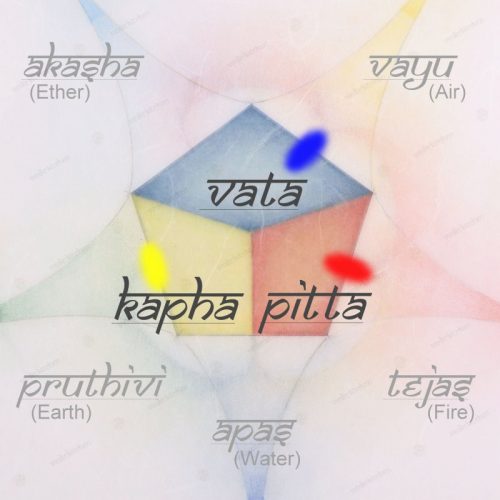
Ayurveda endeavours to keep the doshas in balance in order to maintain or, if necessary, restore health. This is often achieved through an adapted diet, lifestyle, herbal medicine, yoga and other techniques. Ayurveda emphasises taking into account the individual needs of each person to promote a holistic balance of body, mind and spirit.
… consists predominantly of the elements ether and air. Vāta dosha has the characteristics of being light, cold, dry, subtle, mobile and governs movement and communication.

Vāta people tend to be creative and energetic, but also have a tendency towards imbalance, anxiety and dryness. The Vāta dosha significantly controls the function of movement, breathing, excretions and nerve impulses.
… is predominantly made up of the elements fire and water. Pitta dosha has the properties of pungent, hot, slightly oily and liquid and is responsible for digestion and transformation.

Pitta types are often intelligent and fiery but are prone to imbalances, hyperacidity and irritability. The pitta dosha significantly controls the functions of metabolism, digestion, hormone production and body heat.
… is dominated by the elements water and earth. The Kapha dosha has the characteristics of cold, heavy, stable, greasy and sweet and ensures stability and solid structures.
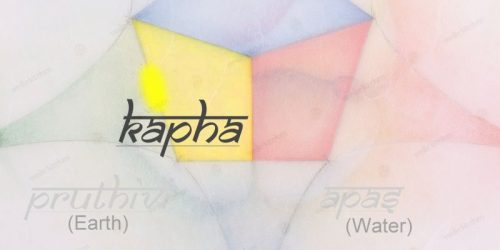
Kapha characters are generally strong and calm, but can struggle with imbalances such as weight gain and constipation. The Kapha dosha is responsible for the function of structure, lubrication, immune system and emotional stability.
… only a few people are pure Vāta, Pitta or Kapha types, which is why there are several combined sub-types of Doshas:
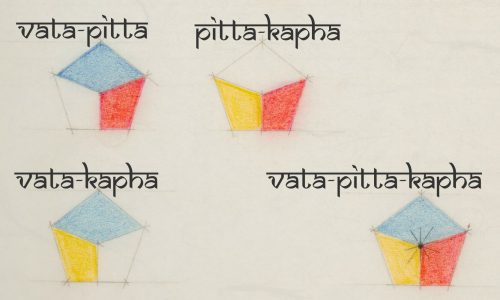
… this type combines the characteristics of Vāta and Pitta. People with this constitution tend to have a thinner or slender build. They can be creative, enthusiastic and full of energy. At the same time, however, they can also be prone to stress, nervousness and restlessness if their doshas are out of balance.
… his is where the characteristics of Pitta and Kapha meet. People with this constitution can have a medium stature and tend to be both goal orientated and balanced. However, they can be prone to imbalances in the digestive system, skin or emotions if Pitta and Kapha are not in balance.
… this constitution combines the characteristics of Vāta and Kapha. People with this combination may have a petite yet strong build. They tend to be creative and stable, but may also suffer from digestive problems if their doshas are imbalanced. It is important to consider both the lightness of Vāta and the stability of Kapha.
… is a combination that has a harmonious interaction of the five elements with the three doshas and is very rare. For people of this type, it is important to maintain harmony and pay attention to the balance of body, mind and soul.
… the reality is not digital but analogue. In addition to the sub-types shown in the diagram above, a finer distinction can also be made if necessary. These sub-types then represent an imbalance between the corresponding doshas.
An example: A Vāta-Vāta-Pitta type represents a stronger weighting of Vāta and a Vāta-Pitta-Pitta type a stronger weighting of Pitta.
However, these other six types of sub-types can be neglected with regard to cooking or recipes. They are mainly used in the medical field. You can find out your own dosha type by taking one of the many Ayurveda tests on the internet.
… play an important role in Ayurvedic nutrition in promoting health and well-being. Ayurveda is a traditional system of medicine that categorises substances into six flavours (Shad Rasas) and assigns them to the three Doshas based on their properties. Each flavour is associated with certain properties and effects on the body, mind and soul.
This are the six flavours (Shad Rasas) of Ayurveda:

The following is a graphic representation of the flavours (Shad Rasas) and the assignments to the underlying elements and Doshas:
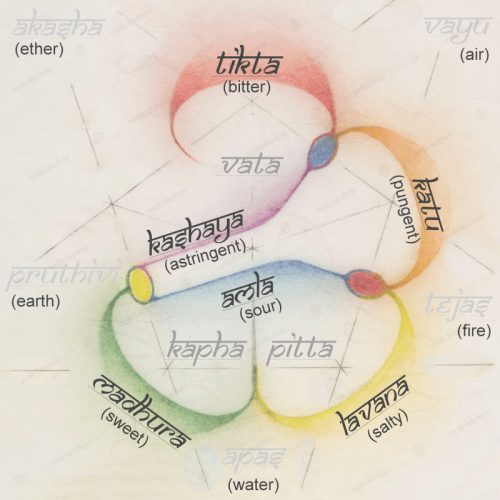
⦁ Bitter (Tikta): The bitter flavour strengthens Vāta and reduces Pitta and Kapha. Bitter foods support detoxification and cleansing, help regulate blood sugar levels and promote liver health.
Bitter foods include foods such as bitter vegetables and fruits (e.g. kale, rhubarb, dandelion and bitter lemon), bitter herbs and spices (e.g. galangal and turmeric) or certain bitter drinks (e.g. coffee and herbal tea) and medicinal plants (e.g. marigold and aloe vera).
⦁ Pungent (Katu): The pungent flavour strengthens Vāta and Pitta and reduces and Kapha. Pungent foods stimulate the metabolism, promote digestion and circulation and can improve blood flow.
Pungent foods include foods such as chilli peppers, ginger, garlic, onions, radishes, mustard and other spices such as black pepper and cayenne pepper.
⦁ Salty (Lavana): The salty flavour strengthens Pitta and Kapha and reduces Vāta. Salty foods improve the sense of taste, help to regulate the fluid balance, support digestion and have a cleansing effect.
Salty foods include foods such as sea and rock salt, sea vegetables (e.g. seaweed), savoury cheeses, pickles and some naturally salty foods such as celery and miso.
⦁ Sweet (Madhura): Sweet flavours increase Pitta and Kapha and reduce Vāta. Sweet foods promote tissue growth, increase vitality and have a calming effect on the body.
Sweet foods include many staple foods such as fruits, grains (such as rice and wheat), dairy products (such as milk and ghee), sweeteners (such as honey and jaggery) and certain vegetables (such as sweet potatoes and carrots).
⦁ Sour (Amla): Sour flavour enhances Pitta and Kapha and reduces Vāta. Sour foods promote digestion and stimulate the metabolism as well as the appetite.
Sour foods include citrus fruits, yoghurt, vinegar, fermented foods and certain vegetables such as tomatoes and tamarind.
⦁ Astringent (Kashaya): The astringent flavour strengthens Vāta and Kapha and reduces Pitta. Astringent foods have a drying and firming effect, promote tissue firmness and can detoxify the body.
Astringent foods include many medicinal herbs, pulses (e.g. lentils and chickpeas), green teas, cranberries, pomegranates and certain vegetables such as broccoli and cauliflower.
In the Ayurvedic diet, it is recommended to include all six flavours in every meal in order to promote a balance of the Doshas (Vata, Pitta, Kapha) in the body. A balance of flavours can help to support different aspects of health and avoid imbalances. It is important to note that recommendations may vary depending on individual constitutional type.
Please note that some tastes can have a dual Dosha association, and the effects can vary depending on the context and the combination of other factors. Ayurveda uses these associations to help balance the Doshas in an individual’s body through diet, lifestyle, and herbal remedies. Balancing the Doshas is considered crucial for maintaining overall health and well-being according to Ayurvedic principles.
Lorem ipsum dolor sit amet, consectetur adipiscing elit. Ut elit tellus, luctus nec ullamcorper mattis, pulvinar dapibus leo.
Lorem ipsum dolor sit amet, consectetur adipiscing elit. Ut elit tellus, luctus nec ullamcorper mattis, pulvinar dapibus leo.
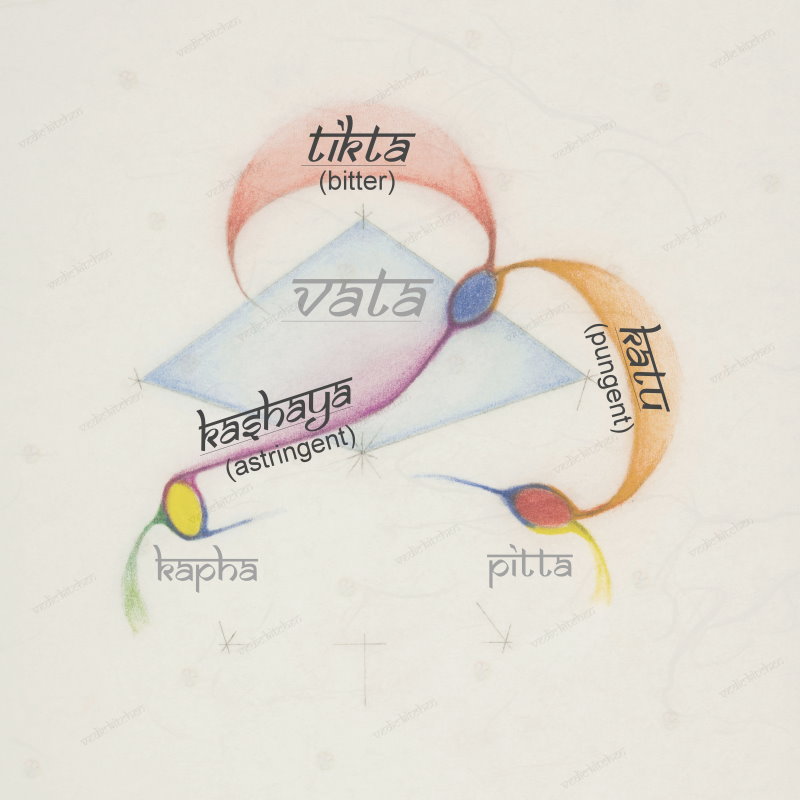
Lorem ipsum dolor sit amet, consectetur adipiscing elit. Ut elit tellus, luctus nec ullamcorper mattis, pulvinar dapibus leo.
Lorem ipsum dolor sit amet, consectetur adipiscing elit. Ut elit tellus, luctus nec ullamcorper mattis, pulvinar dapibus leo.
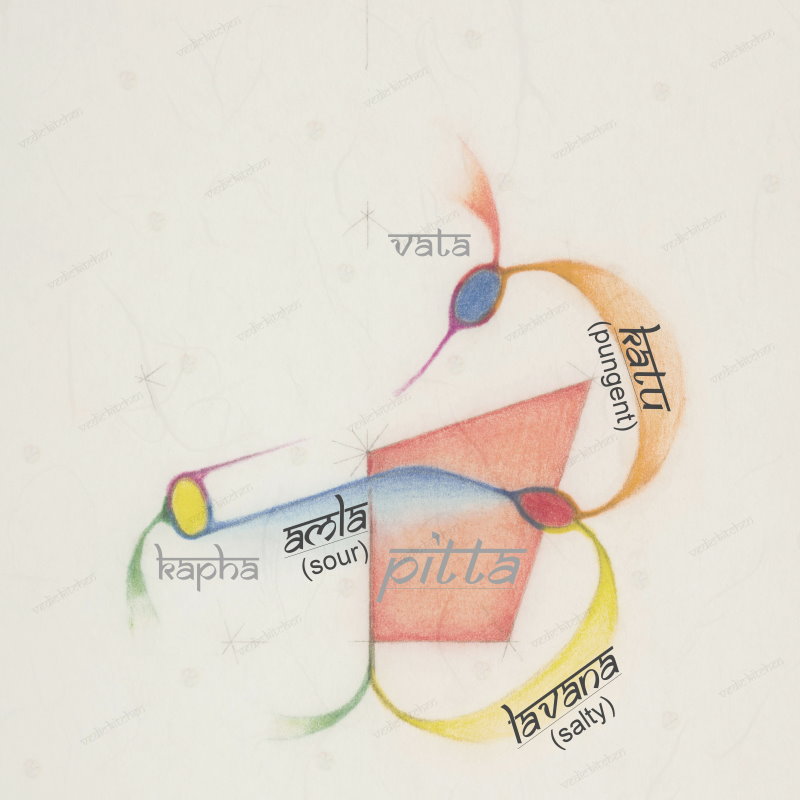
Lorem ipsum dolor sit amet, consectetur adipiscing elit. Ut elit tellus, luctus nec ullamcorper mattis, pulvinar dapibus leo.
Lorem ipsum dolor sit amet, consectetur adipiscing elit. Ut elit tellus, luctus nec ullamcorper mattis, pulvinar dapibus leo.
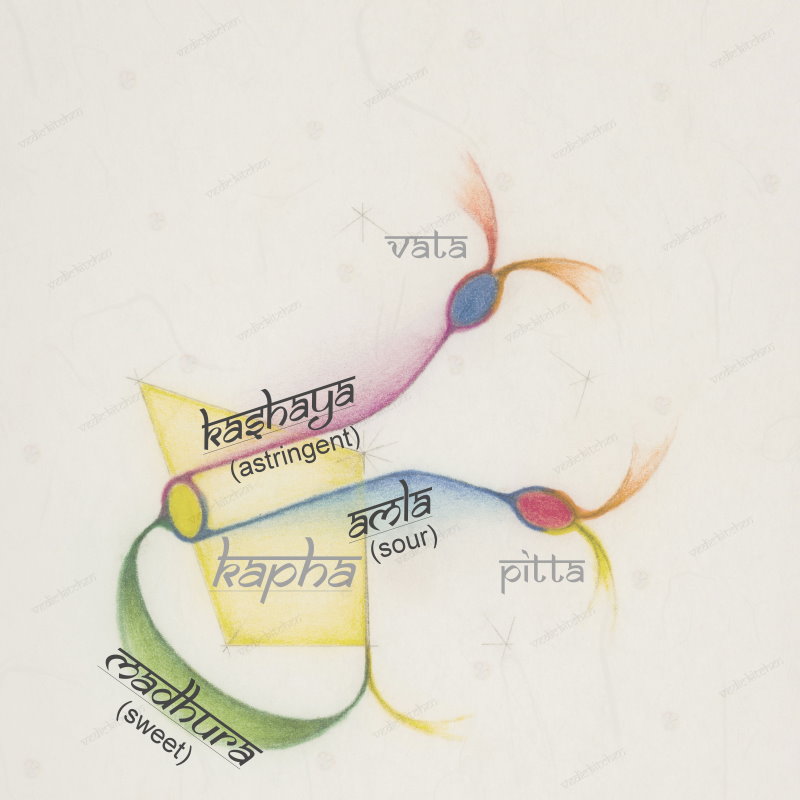
… Prakriti and Vikriti are two important concepts that play a significant role in understanding an individual’s constitution and health.
… refers to to an individual’s natural and inherent constitution as well as their unique physical and psychological makeup. It is determined at the time of conception and is believed to remain relatively constant throughout an individual’s lifetime.
There are three primary Doshas (Vata, Pitta, and Kapha) in Ayurveda, and an individual’s Prakriti is a combination of these Doshas. People are classified into seven different Prakriti types based on the dominance of one, two, or all three doshas.
Understanding the Prakriti is crucial in Ayurveda as it forms the basis for tailoring lifestyle, nurtition and therapeutic recomendations.
… on the other hand, represents to the current state of imbalance or deviation from one’s natural constitution (the Prakriti).
It is determined by assessing the Dosha imbalances (such as diet, lifestyle, environment, stress, and other external influences), as well as further factors like the digestive fire (see Agni ), the state of tissues (see Dhatus) and the waste products (see Mala).
Ayurvedic diagnosis aims to identify the current starte of Vikriti to provide appropriate treatments for restoring balance. Vikriti is dynamic and can change based on various factors, so it requires regular assessment to maintain optimal health.
… understanding both Prakriti and Vikriti is crucial in Ayurveda for personalized health management. Treatment and lifestyle recommendations are often tailored to an individual’s Prakriti and the specific imbalances present in their Vikriti.
It’s important to note that Ayurveda views health as a state of balance and harmony between the doshas, and the goal of Ayurvedic practices is to maintain this balance for overall well-being or, if necessary to restore. Ayurvedic consultations typically involve an in-depth analysis of an individual’s Prakriti and Vikriti to guide personalized recommendations for diet, lifestyle, herbal remedies, and other therapeutic interventions.
Prakruti, a Sanskrit definitive term literally means nature or constitution or temperament. It is the typical feature of a person which decides the health, body structure, features of a person. In simple words, Prakruti is the constitution. Prakruti is an inherent nature of an individual determined at the time of your birth, that at the time of union of sperm and ovum, predominance of five elements and Dosha decides the Prakruti of every individual which cannot be changed during your lifetime. Ayurveda broadly classified human nature in two types, physical and mental nature. According to Ayurveda, the human body is composed of the Mahābhūtas and Tridoshas. These forms the basis of Prakruti.
Mahābhūtas or five basic elements are Ākāsha, Vāyu, Tejas, Āpas and Pruthivī simply correlated to space, air, fire, water and earth respectively. Tridosha or three humors of the body are Vata, Pitta and Kapha. These Doshas get their qualities from the combination of above mentioned five basic elements in nature. The Vata-Dosha is the result of air and space. Pitta-Dosha is caused by fire and water and Kapha-Dosha is the result of earth and water elements.
Prakruti means manifestation of special characteristics due to predominance of the Tridoshas (Vata, Pitta, Kapha) and these Prakruti indicates predominance of specific Doshas in a human being. There are other factors which also determine the constitution of a human body in minor ways. The famous ancient physican Caraka has mentioned several additional factors which determine the Prakruti such as nature of the season, condition inside the uterus, food and other regimens adopted by mother during pregnancy, sperm – ovum of father and mother. These factors get afflicted with one or more of the Doshas which are dominantly associated with the above mentioned factors. Therefore Prakruti of some people is dominated by Vata, some others by Pitta, some others by Kapha.
Ayurveda describes seven types of Prakruti. They are Vata-Prakruti, Pitta-Prakruti, Kapha-Prakruti, Vata-Pitta-Prakruti, Pitta-Kapha-Prakruti, Kapha-Vata Prakruti and Tridosha Prakruti.
People with predominant Vata-Dosha are usually quite thin, having a light bone and muscular structure. They are very creative and active not only physically but also in their thought patterns because they have many ideas, such people are more prone to illness because they are usually not very strong physically and have a weaker immune system.
Persons who have high amounts of Pitta or Pitta Prakruti are likely to have explosive character and a strong digestive system. They usually have a medium body size, build muscles at their normal pace and have good strength. They can appear aggressive and determined, but they usually have a great sense of justice and work hard for their goals.
Pitta type of people can eat and digest heavy meals easily.
Kapha Prakruti people are usually well built, good looking and have healthy skin. Such people are physically strongest and also have a robust immune system. They like slow and steady activities like swimming and walking. They have a good memory, amazing endurance and a great sense of loyalty.
But it is difficult to put people in these three categories because most people are combination types of Doshas. But there are only a few lucky people where all the three Doshas are in balance. The composition of Doshas within us is what makes us individuals. If we know our predominant Doshas, we can adapt our diet and our lifestyle in order to stay balanced and maintain our health. Then our body and mind are in alignment with nature.
Vikruti is the set of imbalances that you are currently experiencing in the body and mind. The word Vikruti conveys the meaning change from Prakruti or natural state. Further the disequilibrium of body components denoting pathological state. It is based on internal and external factors affecting your body and mind now. These attributes change with time, life cycle, seasons, diet and lifestyle changes, stress level since these affect appetite, weight, what skin and hair looks like, cognitive function and state of mind.
Ayurveda asserts that 80 diseases happen because of Vata imbalance, 40 diseases occur due to Pitta imbalance and 20 diseases occur due to Kapha imbalance.
When Vata-Dosha is imbalanced in the body, a person may suffer from specially pain related diseases. Also he may feel nervousness, anxiety, panic attacks, twitches, tremors and spasms. And anything to do with the nervous system, anything associated with immunosuppression, irregular digestion that is unpredictable from day to day, insomnia, dry, flaky skin and brittle, cracking and peeling nails, constipation, gas, bloating and hard stools.
Pitta imbalance is usually associated with inflammation or acidity in the body or in the mind. Excess Pitta produces heat, burning sensation, hot flashes and anger in all forms. Some typical signs of Pitta aggravated are any kind of inflamed skin rash, acne, acid reflux with heartburn, nausea, loose stools and diarrhea, hyper metabolism and voracious, almost insatiable appetite, frustration, anger, irritability and jealousy.
Kapha imbalances are typically associated with stagnation and heaviness in mind or body. Some characteristic signs of Kapha imbalance are excess mucus in the respiratory system and in stools, thick white coating on the tongue, infrequent and sluggish bowel movements, emotional eating, high body weight, difficulty losing weight and easily gains, feeling slow, foggy, dull, lethargic or heavy in mind and body, stubbornness and complacency.
Based on the properties and the imbalance of Dosha in the body specific diseases can be manifest according to the predominance of aggravated Dosha in the body. Kapha body types for gaining weight are quite well known and obesity is in turn linked with a number of chronic diseases such as heart diseases, hypertension, diabetes, all of which increasingly viewed collectively as metabolic syndromes.
Similarly looking at the properties of Pitta body type it can be predicted that such individuals can have a propensity to develop ulcers, bleeding disorders and skin disorders more commonly.
Vata-Dosha types can have propensity to develop neurological problems, dementia, movement and speech disorders, arrhythmias and related chronic diseases as well.
Having good understanding about the Prakruti and the Vikruthi of the patient may be important to diagnose the disease correctly and plan the treatment protocol for the patient to restore the imbalanced Doshas and it learns how to prevent diseases. Then you will be able to live your life accordingly. So that you prevent disease and you’ll be living in accordance with your Prakruti at that time.
So it’s clear that Prakruti in Ayurveda is the constitution of the body from birth and Vikruti means the nature of the imbalance that is present within you. With that knowledge you’ll be able to prevent disease and treat disease correctly.
… in Ayurveda, the term Agni refers to the digestive fire or metabolic fire within the body. It is a crucial concept in Ayurvedic philosophy as it is believed to govern the digestive and metabolic processes, playing a vital role in overall health and well-being.
The term Agni is derived from the Sanskrit word meaning (digestive) fire. According to Ayurveda, Agni is responsible for transforming the food we consume into nutrients that can be assimilated by the body. This process is crucial for the nourishment of tissues and the elimination of waste products (Ama).
There are several types of Agni described in Ayurveda, and their balance is considered essential for maintaining optimal health.
The three main types of Agni are:
⦁ Digestive Fire (Jathara Agni): This is the primary Agni located in the stomach and is responsible for digesting the food we eat. It breaks down the ingested food into its basic components, allowing for the absorption of nutrients.
⦁ Metabolic Fire (Bhuta Agni): This Agni operates at the cellular level and is responsible for the transformation of nutrients into energy. It governs the metabolic processes within the cells.
⦁ Tissue Fire (Dhatu Agni ): This Agni is associated with the transformation of nutrients into the various bodily tissues. It ensures that the right nutrients reach the right tissues, contributing to the formation and maintenance of tissues in the body.
Maintaining a balanced Agni is crucial for preventing various health issues. If Agni is too weak, it can lead to incomplete digestion and the accumulation of toxins (ama) in the body. On the other hand, excessive Agni may lead to conditions like hyperacidity or inflammation.
Ayurveda recommends a balanced diet, proper eating habits, and lifestyle practices to support and enhance Agni. Factors such as the choice of foods, meal timings, and the individual’s constitution (Prakriti) are taken into consideration when addressing Agni in Ayurvedic practices.
It’s important to note that Ayurveda is a holistic system of medicine, and individualized approaches are often recommended based on a person’s unique constitution and imbalances. If you’re interested in incorporating Ayurvedic principles into your lifestyle, it’s advisable to consult with a qualified Ayurvedic practitioner for personalized guidance.
… in Ayurveda, the term Ama refers to the concept of undigested or unmetabolized waste or toxins that accumulate in the body. It is considered a root cause of many diseases in Ayurvedic philosophy. According to Ayurveda, the accumulation of Ama occurs due to improper digestion and metabolism, leading to the formation of a sticky, harmful substance.
To address the presence of Ama, Ayurvedic practices often include dietary and lifestyle changes, herbal remedies, detoxification therapies (known as Panchakarma), and other holistic approaches. The goal is to balance the body’s doshas (Vata, Pitta, and Kapha), improve digestion, and eliminate Ama from the body.
Dhatu …
… in Ayurveda, the term Dhatu refers to the seven fundamental tissues or elements that constitute the human body. These tissues are considered building blocks and play a crucial role in maintaining overall health. The concept of Dhatus is central to Ayurvedic medicine, and understanding them is essential for assessing and promoting well-being.
The seven Dhatus are:
⦁ Plasma (Rasa Dhatu): Rasa is the first Dhatu and represents the plasma or the liquid part of the blood. It nourishes the body and provides the basis for the formation of the subsequent Dhatus.
⦁ Blood (Rakta Dhatu): Rakta refers to the red blood cells and is responsible for nourishing the body’s tissues. It carries oxygen and nutrients to cells and removes waste products.
⦁ Muscle (Mamsa Dhatu): Mamsa represents the muscular tissue of the body. It provides structural support and helps in the movement of joints and limbs.
⦁ Fat (Meda Dhatu): Meda is the adipose tissue or fat, which provides insulation, energy storage, and supports various bodily functions.
⦁ Bone (Asthi Dhatu): Asthi refers to the skeletal system, including bones and teeth. It provides structural support, protects organs, and serves as a reservoir for minerals.
⦁ Bone Marrow and Nervous Tissue (Majja Dhatu): Majja encompasses the bone marrow and the nervous tissue. It plays a role in the formation of blood cells and supports the nervous system.
⦁ Reproductive Tissue (Shukra Dhatu): Shukra is the reproductive tissue, responsible for the formation of semen in men and eggs in women. It is vital for reproductive health.
In Ayurveda, the balance and proper functioning of these Dhatus are essential for maintaining health and preventing diseases. Imbalances in the Dhatus are believed to be at the root of various health issues, and Ayurvedic treatments often focus on restoring this balance through lifestyle, diet, and herbal remedies. Ayurvedic practitioners assess the state of the Dhatus to diagnose health conditions and prescribe personalized treatments.
Mala …
… in Ayurveda, the term Mala typically refers to bodily wastes or excretions, and it’s an essential concept in Ayurvedic medicine. In Ayurveda, there are three primary types of waste products known as Trimala:
⦁ Sweat (Sweda): Sweat is another form of waste elimination in Ayurveda. It is the result of the body’s efforts to cool itself and eliminate excess heat.
⦁ Urine (Mutra): This pertains to the waste fluids excreted by the kidneys and is associated with the urinary system. Proper elimination of urine is considered crucial for maintaining balance in the body.
⦁ Feces (Purisha): This represents the waste material from the digestive system and is associated with the colon. Ayurveda emphasizes the importance of regular and complete elimination of feces for maintaining health.
The proper elimination of these waste products is essential for maintaining a balance of the three Doshas (Vata, Pitta, and Kapha) in the body according to Ayurvedic principles. Any imbalance in the elimination of these waste products is believed to contribute to various health issues.
Seasonal and Circadian Rhythms …
… Ayurveda acknowledges the influence of seasons (Ritu) and daily rhythms (Dinacharya) on health. Seasonal variations in diet and lifestyle recommendations are made to align with nature’s cycles and maintain balance.
While Ayurveda, the traditional system of medicine that originated in India, does not explicitly use the terms „seasonal rhythms“ and „circadian rhythms“ in the same way modern science does, it does recognize the influence of nature and time on health. Ayurveda emphasizes the concept of doshas, which are the three fundamental energies or principles that govern various physiological and psychological functions in the body.
Seasonal Rhythms in Ayurveda …
Ayurveda acknowledges the impact of seasons on an individual’s well-being. The year is divided into six seasons, each lasting for about two months:
⦁ Vasant (Spring): Mid-March to mid-May
⦁ Grishma (Summer): Mid-May to mid-July
⦁ Varsha (Monsoon): Mid-July to mid-September
⦁ Sharad (Autumn): Mid-September to mid-November
⦁ Hemant (Pre-winter): Mid-November to mid-January
⦁ Shishir (Winter): Mid-January to mid-March
Ayurveda suggests that during each season, certain doshas may be aggravated. For example, the pitta dosha may be aggravated in summer, while vata dosha may be influenced during autumn and early winter. Lifestyle and dietary recommendations in Ayurveda are often tailored to balance these doshas during different seasons.
Circadian Rhythms in Ayurveda …
Ayurveda recognizes the importance of daily routines, or Dinacharya, which aligns with the modern concept of circadian rhythms. The day is divided into six different periods, each associated with specific Doshas:
⦁ Kapha Time (6 a.m. – 10 a.m.): This is a time of increased Kapha-Dosha. It’s recommended to engage in light exercise, meditation, and have a light breakfast during this period.
⦁ Pitta Time (10 a.m. – 2 p.m.): Pitta-Dosha dominates during these hours. It’s advised to have the main meal of the day, as digestion is strongest.
⦁ Vāta Time (2 p.m. – 6 p.m.): ⦁ Vata-Dosha becomes more predominant. This is a good time for creative and intellectual activities.
⦁ Kapha Time (6 p.m. – 10 p.m.): The evening Kapha-Dosha time suggests winding down with a light dinner and preparing for sleep.
⦁ Pitta Time (10 p.m. – 2 a.m.): Pitta-Dosha again becomes dominant during the early part of the night. It’s recommended to be in a deep sleep during this period for optimal physical and mental repair.
⦁ Vāta Time (2 a.m. – 6 a.m.): The pre-dawn hours are influenced by Vata-Dosha. It’s ideal to wake up early, perform cleansing practices, and engage in gentle exercises.
By aligning daily activities and routines with these natural rhythms, Ayurveda aims to promote balance and harmony within the body and mind. Keep in mind that Ayurveda is a holistic system, and individualized recommendations may vary based on one’s unique constitution (Prakriti) and current imbalances (Vikriti). Consultation with a qualified Ayurvedic practitioner is recommended for personalized advice.
… are the three fundamental qualities (Sattva, Rajas, and Tamas) that are believed to govern the mind and body. They have significant influences on nutrition according to the Ayurvedic rules. Here’s how each the Trigunas can affect nutrition choices and their impact on the body:
… represents purity, harmony, and balance. It is associated with qualities such as clarity, intelligence, wisdom, and contentment. When Sattva is predominant, it leads to mental clarity, peacefulness, and a sense of overall well-being. Practices such as meditation, yoga, and consuming wholesome, nourishing foods are believed to cultivate Sattva.
⦁ Sattvic foods are considered pure, light, and nourishing. They promote clarity of mind, spiritual growth, and overall well-being.
⦁ Sattvic nutrition includes fresh fruits and vegetables, whole grains, nuts, seeds, legumes, dairy products (especially fresh and organic), and mild spices.
⦁ These foods are easily digestible, provide sustained energy, and support a calm and balanced state of mind.
⦁ Eating Sattvic foods is believed to promote mental clarity, emotional balance, and spiritual awareness.
Examples of Sattvic foods include rice, lentils, leafy greens, sweet fruits, ghee (clarified butter), and herbal teas.
… is characterized by activity, dynamism, and passion. It is associated with qualities such as ambition, desire, restlessness, and agitation. When Rajas is predominant, it can lead to excessive busyness, stress, and overstimulation. While some level of Rajas is necessary for accomplishing goals and engaging with the world, excessive Rajas can disrupt inner balance and lead to imbalance in the mind and body.
⦁ Rajasic foods are stimulating, intense, and often result in increased energy and activity.
⦁ Rajasic nutrition includes spicy foods, caffeinated beverages, fried foods, overly processed foods, and foods with strong flavors or odors.
⦁ These foods can increase metabolism, but excessive consumption may lead to restlessness, irritability, and overstimulation of the mind.
⦁ While some level of Rajasic foods can be beneficial for motivation and productivity, excessive intake can disrupt inner balance and lead to agitation.
Examples of Rajasic foods include coffee, tea, chocolate, garlic, onions, hot peppers, and heavily spiced dishes.
… is the quality of inertia, darkness, and ignorance. It is associated with qualities such as lethargy, dullness, confusion, and stagnation. When Tamas is predominant, it can lead to laziness, depression, and a lack of motivation. Practices such as mindfulness, physical activity, and consuming energizing foods are believed to counteract Tamas and promote greater vitality and clarity.
⦁ Tamasic foods are heavy, dull, and promote inertia or stagnation.
⦁ Tamasic nutrition includes processed foods, deep-fried foods, stale or overripe foods, excessive meat, alcohol, and foods with artificial additives or preservatives.
⦁ These foods are often difficult to digest, can lead to lethargy, and may cloud the mind.
⦁ Consuming Tamasic foods in excess can lead to a feeling of heaviness, sluggishness, and mental fog.
Examples of Tamasic foods include fast food, frozen meals, red meat, alcohol, refined sugar, and foods high in fat or cholesterol.
These three Gunas are present in varying degrees in all aspects of the universe, including our minds, bodies, and the foods we eat. The goal of Ayurveda is to cultivate Sattva while minimizing Rajas and Tamas, thereby promoting health, harmony, and spiritual growth.
Maintaining a balance between the three Gunas in our nutrition is essential for promoting optimal health and well-being. A nutrition that emphasizes Sattvic foods while minimizing Rajasic and Tamasic foods is believed to support physical vitality, mental clarity, and spiritual growth.
Further more, the three Gunas can affect the three Doshas (Vāta, Pitta, Kapha). As the most bio-energetic forces, governing various physiological and psychological functions in the body the Triunas are influenceing in different ways:
… is characterized by qualities such as Rūksha (dry), Laghu (light), Shīta (cold), Khāra (rough), Sūkshma (subtle), Chala (mobile), and Vishada (clear ).
⦁ Sattvic influences can help balance Vāta by promoting mental clarity, calmness, and stability. Sattvic foods like cooked grains, root vegetables, and nourishing soups can be grounding for Vāta.
⦁ Excessive Rajas can aggravate Vāta, leading to increased restlessness, anxiety, and overactivity. Spicy, caffeinated, and overly stimulating foods may exacerbate Vāta imbalances.
⦁ Excessive Tamas can also disturb Vāta ta balance, causing feelings of heaviness, lethargy, and mental dullness. Heavy, fried, and processed foods can worsen Vāta imbalances.
… is characterized by qualities such as Ushna (hot), Tikshna (sharp), Snigdha (oily), Laghu (light), Chala (mobile), and Drava (liquide).
⦁ Sattvic influences can help pacify Pitta by promoting emotional harmony, coolness, and moderation. Sattvic foods like sweet fruits, leafy greens, and dairy products can have a cooling effect on Pitta.
⦁ Excessive Rajas can aggravate Pitta, leading to heightened aggression, competitiveness, and irritability. Spicy, sour, and pungent foods may increase Pitta imbalances.
⦁ Excessive Tamas can also disturb Pitta balance, causing emotional heaviness, sluggish digestion, and a lack of motivation. Heavy, greasy, and overly processed foods can worsen Pitta imbalances.
Kapha is characterized by qualities such as Guru (heavy), ???? slow, Shīta (cold), Snigdha ( oily), Slakshna (smooth), Sandra (dense) and ??? stable.
⦁ Sattvic influences can help balance Kapha by promoting mental clarity, lightness, and enthusiasm. Sattvic foods like fresh fruits, vegetables, and whole grains can help stimulate Kapha.
⦁ Excessive Rajas can aggravate Kapha, leading to increased attachment, possessiveness, and stubbornness. Heavy, rich, and overly sweet foods may exacerbate Kapha imbalances.
⦁ Excessive Tamas can also disturb Kapha balance, causing feelings of lethargy, depression, and emotional withdrawal. Heavy, processed, and overly sedating foods can worsen Kapha imbalances.
Overall, maintaining a balance between the Trigunas and understanding their effects on the Doshas is essential in Ayurveda for promoting optimal health and well-being.